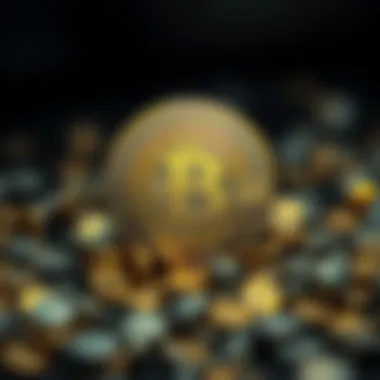Understanding Non-Fungible Tokens in the Digital Age


Intro
In recent times, the buzz surrounding non-fungible tokens (NFTs) has reached a fever pitch. What seemed like a niche market now commands the attention of investors, artists, and tech enthusiasts alike. Yet, before diving into the depths of NFTs themselves, it is imperative to understand the foundational elements that make them possible—the world of cryptocurrency and blockchain technology. Grasping these concepts can help demystify why NFTs have become such a pivotal part of the digital landscape.
Understanding Cryptocurrency Concepts
Blockchain Technology Explained
At its core, blockchain technology is a decentralized digital ledger that records transactions across many computers. This means that once information is entered into a blockchain, it is almost impossible to alter or delete. Think of it as a massive Google Doc that numerous users can access and edit but with strict control over modifications—once something is set, it stays set.
Within this framework, NFTs stand out because they represent unique assets, in contrast to cryptocurrencies like Bitcoin or Ethereum, which are fungible and can be exchanged for one another. NFTs are stored on the blockchain, and this unique referencing system gives them their value. Every NFT has a distinct identifier, allowing it to be differentiated from others, making them perfect for digital art, collectibles, and other unique items.
Key Terms Every Investor Should Know
To navigate through the NFT landscape effectively, familiarizing oneself with specific terminologies is crucial. Here are some key terms:
- Smart Contracts: Self-executing contracts where the terms are written into code. They are crucial for managing NFT transactions without intermediaries.
- Gas Fees: These are transaction fees paid to miners on the blockchain. Understanding these can help in budgeting for NFT purchases.
- Minting: The process of creating a new NFT and registering it on a blockchain. It's how digital files are transformed into unique tokens.
- Wallets: These are digital tools that allow users to store and manage their cryptocurrency and NFTs securely.
"NFTs represent a shift in how we think about ownership in the digital realm, blending technology with art and creativity in unprecedented ways."
Market Analysis and Trends
Current Market Trends in Cryptocurrency
As interest in NFTs escalates, understanding current trends within the cryptocurrency landscape becomes essential. The market is characterized by volatility but also incredible potential for growth. Recent trends indicate a surge in NFT marketplaces such as OpenSea and Rarible, which facilitate the buying and selling of these tokens. Moreover, even traditional companies and celebrities are entering the space; for instance, high-profile drops from artists like Beeple have reshaped public perceptions about digital art.
Investment Strategies for Different Market Conditions
Navigating the NFT market can be akin to sailing through choppy waters. Here are a few strategies that investors might consider:
- Diversification: Just like stocks, it's wise not to put all your eggs in one basket. Consider investing in various types of NFTs, from digital art to virtual real estate.
- Research and Analysis: Before diving into any purchase, do your homework. Analyzing an NFT's provenance and the artist behind it could prove valuable.
- Timeliness: The NFT market is fast-paced, and being ahead of the curve might mean jumping on trends before they become mainstream.
In summary, comprehending the underpinnings of blockchain and key concepts around NFTs is critical for anyone looking to delve deeper into the digital ownership sphere. The landscape is still evolving, but with each wave of advancement, new opportunities arise for savvy investors and collectors willing to engage with this dynamic market.
For more insight into the technology behind NFTs, check out resources such as Wikipedia and Britannica.
Defining Non-Fungible Tokens
Non-fungible tokens, often abbreviated as NFTs, represent a groundbreaking advancement in the realm of digital ownership. The significance of understanding NFTs extends beyond their role as mere digital collectibles or hype-laden investments; it encapsulates the very future of how we perceive value, ownership, and creativity in the digital age. Grasping the concept of non-fungibility is crucial for investors, traders, analysts, educators, and enthusiasts alike. The more we delve into this topic, the clearer it becomes that NFTs hold the potential to disrupt many industries.
At their core, NFTs are digital representations of ownership for unique items or assets. Unlike cryptocurrencies such as Bitcoin or Ethereum, which are fungible and can be exchanged one-for-one without loss of value, each NFT is distinct. This uniqueness is not merely a characteristic; it's central to the definition of non-fungibility. Whether it’s art, music, gaming assets, or virtual real estate, the information stored within each NFT distinguishes it from others, which creates a captivating landscape of possibilities.
In a nutshell, understanding non-fungible tokens involves exploring several key elements:
- The nature of non-fungibility itself,
- The technological underpinnings that make NFTs viable,
- Their myriad applications across various sectors,
- The economic implications of their growing popularity.
In particular, businesses and creators can benefit greatly from this understanding, as NFTs offer new avenues for monetization. As the digital landscape evolves, knowing how to navigate the NFT space helps stakeholders make informed decisions, whether that be in investments, creative pursuits, or technology development. The absence of a comprehensive understanding could lead to missed opportunities or misjudgments about this emerging ecosystem.
"The future of ownership isn't just digital - it's uniquely digital."
The Meaning of Non-Fungibility
Non-fungibility refers to the property of an asset that makes it unique and irreplaceable, as opposed to fungible assets, which can be exchanged freely without losing value. For example, if you swap a $10 bill for another $10 bill, you have the same value. But you can't do that with a unique item like a piece of artwork. That painting isn't the same as any other; it's one of a kind.
In the digital realm, non-fungibility enables creators to produce digital assets that hold inherent value. This can be in the form of digital art, music tracks, or any item that can be distinctly identified. Each NFT contains metadata that verifies its uniqueness and ownership rights, making it a personalized asset in spaces that are generally considered infinite. This idea transitions seamlessly into various industries, from gaming to music, where the authenticity of ownership matters greatly.
Comparison with Fungible Tokens
The distinction between non-fungible tokens and fungible tokens is like comparing apples to oranges. Fungible tokens, such as Bitcoin or Ethereum, are interchangeable, meaning one unit holds the same value as another. They’re used primarily for transactions and trading within the digital economy. For example:
- Bitcoin (BTC): Always holds equal value, no matter the transaction.
- Ethereum (ETH): Can be swapped with any other Ethereum unit without loss of value.
In contrast, NFTs operate on principles of uniqueness and permanence. Some distinguishing characteristics include:


- Uniqueness: Each NFT has a unique identifier, making ownership distinct.
- Scarcity: Creators can limit the number of NFTs produced for an asset, enhancing its value due to limited availability.
- Ownership Record: The blockchain keeps a public record of ownership, giving clarity and security.
The concept of fungibility in the digital world contrasts sharply with non-fungibility, presenting a dichotomy that shapes how values are perceived and established in both digital and physical realms. Understanding these differences is crucial for anyone looking to navigate the evolving landscape of digital assets.
As we continue exploring other aspects of NFTs, we will uncover the implications of their technological foundations and the opportunities they create across multiple industries.
The Technological Foundation of NFTs
The emergence of non-fungible tokens hinges greatly on their underlying technological framework. Understanding this foundation is essential for comprehending how NFTs function and the broader implications they carry. This section will explore the two main pillars of this technology: blockchain and smart contracts. Unpacking these elements provides clarity on how NFTs have disrupted traditional ownership models and created new avenues for value and creativity in the digital age.
Understanding Blockchain Technology
Blockchain serves as the backbone for all non-fungible tokens, enabling their existence and functionality. At its core, blockchain is a decentralized ledger that records transactions across many computers so that the record cannot be altered retroactively. This characteristic of immutability makes blockchain incredibly reliable for tracking ownership and ensuring authenticity.
The core features of blockchain technology include:
- Decentralization: This means no single entity has control. Data is spread across a network, minimizing the risk of fraud and manipulation.
- Transparency: Every transaction is publicly accessible on the blockchain, ensuring accountability. Anyone can view the transaction history of NFTs, which is crucial for buyers wanting to verify provenance.
- Security: Cryptographic techniques secure the data stored on blockchains, significantly reducing the risk of hacking or data loss.
For example, when a digital art piece is minted as an NFT on a blockchain such as Ethereum, the token created is uniquely identifiable, tied to the specific artwork. This is where the concept of non-fungibility shines, as each token has distinct characteristics that set it apart from any other token. As a result, each NFT holds its own value and narrative, making it a unique asset in its own right.
"In a world of digital replication, blockchain shines as a beacon of authenticity."
Smart Contracts and Their Role
Alongside blockchain technology, smart contracts are a keystone in enabling non-fungible tokens to operate as they do. Smart contracts are self-executing contracts with the terms of the agreement written directly into code. They are processed and executed on the blockchain, highlighting the seamless functionality between the technology and the tokens themselves.
The advantages of smart contracts include:
- Automation: Once set in motion, smart contracts execute automatically when pre-defined conditions are met. For NFTs, this could mean automatically transferring ownership upon purchase.
- Trustless Transactions: Buyers and sellers don’t need to trust one another to complete a transaction. The execution of a smart contract ensures that the terms are honored without intermediary influence.
- Customizability: Smart contracts can be programmed with specific rules about royalties, secondary sales, and other factors important to artists and creators. For instance, if an artist sells an NFT, they can ensure they receive a percentage of subsequent resales automatically.
Integrating these smart contracts with NFTs increases their utility beyond mere collectibles. They redefine ownership and game mechanics in various sectors such as gaming, art, and real estate. Investors and creators benefit from these self-regulating, automated facets of blockchain technology, creating a more transparent and equitable digital economy.
Key Characteristics of Non-Fungible Tokens
The realm of non-fungible tokens (NFTs) is vast, and at its core lies a set of key characteristics that define their utility and significance in the digital landscape. Understanding these characteristics not only sheds light on why NFTs have gained immense traction but also reveals the dynamics of their market and application across various sectors. The focus on uniqueness, ownership, and interoperability are pivotal in comprehending the true nature of NFTs and their implications for the future of digital assets.
Uniqueness and Scarcity
NFTs thrive on their uniqueness. Unlike traditional currencies that can be exchanged or traded at equal values, each NFT possesses a distinct identity; this identity is often tied to a digital asset such as art, music, or virtual real estate. This uniqueness is encoded on the blockchain, ensuring that each token can be traced back to its original source.
The concept of scarcity is equally crucial. Many NFTs are intentionally designed to be limited in quantity. For instance, artists might release only a certain number of copies of their digital artwork as NFTs. This scarcity fosters demand, consequently elevating the perceived value of these tokens. The interplay between uniqueness and scarcity can create vibrant markets where collectors are eager to own one-of-a-kind pieces.
"Scarcity creates value; in a world flooded with digital content, NFTs cut through the noise by offering something that can’t just be copied and pasted."
Ownership and Provenance
Ownership in the digital world has historically been muddled. But NFTs have changed the game. By utilizing blockchain technology, NFTs give verified proof of ownership, a significant shift from the murky waters of traditional digital transactions. This confirmation of ownership is not just a superficial claim; it exists publicly on the blockchain, making it immutable and secure.
Alongside ownership comes the idea of provenance—an essential aspect especially in the art world. Provenance refers to the history of ownership in an artwork, showcasing its authenticity and heritage. With NFTs, collectors can easily track who created the piece, where it has been sold, and who currently owns it. This trail of ownership helps bolster confidence among buyers, reducing the risk of fraud and counterfeit goods. Moreover, it gives artists a fairer platform, allowing them to garner true recognition for their work.
Interoperability and Marketplaces
NFTs gain an edge through their interoperability. Unlike traditional assets, which often exist within isolated ecosystems, NFTs can be transferred across various platforms. This versatility allows users to marginalize barriers to entry across different digital marketplaces, creating pathways for broader engagement and increased liquidity.
Numerous marketplaces have emerged, such as OpenSea and Rarible, facilitating transactions and fostering vibrant communities of creators and collectors. Each marketplace may cater to specific audiences or types of assets, whether it be virtual real estate, digital art, or collectibles. The growth of these platforms not only enhances accessibility but also stimulates innovation within the NFT space, swimming against the tide of traditional finance and art markets.
In summary, grasping the key characteristics of non-fungible tokens is fundamental for anyone looking to understand their broader implications in the ecosystem of digital assets. With their uniqueness, ownership verification, and interoperability, NFTs are poised not just as mere collectibles but as transformative elements across a myriad of industries.
For more insights, consider checking resources like Wikipedia, or dive into trending discussions on platforms like Reddit for community perspectives.
Applications of NFTs Across Industries
In recent years, non-fungible tokens (NFTs) have emerged as a significant force across various industries. Their unique properties and capabilities have transformed how value is created, shared, and traded in the digital realm. This section explores the diverse applications of NFTs, emphasizing their relevance in art, gaming, real estate, and the music industry.
NFTs in Art and Collectibles


The art world has seen a renaissance spurred by the rise of NFTs. Unlike traditional art forms, which rely on physical presence for value, NFTs authenticate digital artworks, granting them uniqueness and ownership in a way that was previously unattainable. Artists can tokenize their work, creating a verifiable digital certificate that accompanies the piece. This shift not only empowers artists by giving them control over their creations but also opens doors to new revenue streams.
Moreover, blockchain technology ensures provenance; the history of ownership can be tracked with complete transparency. This leads to trust among buyers, which is paramount in a space previously afflicted by counterfeit art. High-profile sales, such as Beeple's "Everydays: The First 5000 Days" auctioning for a staggering $69 million, showcase how NFTs in art significantly raise new avenues for creativity and investment.
Gaming and Virtual Goods
In gaming, NFTs have transformed how players interact with virtual environments. Virtual items, characters, or even land can be owned and traded as NFTs. This ownership grants players real stakes in the games they play, rather than simply renting their engagement. With ownership, players can buy, sell, or trade items seamlessly on various marketplaces.
This model fosters a new economic ecosystem where players can earn money by investing time and resources into a game. Platforms like Axie Infinity have demonstrated this potential, allowing users to breed, care for, and trade digital pets with tangible value. Gamers are no longer just participants; they become investors and potential entrepreneurs in their virtual realms.
Real Estate and Digital Ownership
The real estate sector is also witnessing the transformative power of NFTs. Digital ownership of virtual properties can be as valuable as physical real estate. Platforms are emerging where digital land can be bought and sold, proving that ownership of land is extending into the metaverse. Furthermore, NFTs can simplify transactions by streamlining property rights, making it easier to transfer ownership with a click.
For instance, Decentraland allows users to purchase, develop, and sell virtual land, creating a digital ecosystem where ownership mimics real-world real estate markets. Additionally, the use of smart contracts in these transactions provides a measure of security and efficiency, ensuring that agreements are upheld transparently and automatically. This innovation signifies a shift towards more democratic access to real estate, beyond the traditional constraints of physical location and finance.
Impact on the Music Industry
The music industry is another field experiencing significant disruption through NFTs. Artists are leveraging NFTs to change how they monetize music and engage with fans. By issuing exclusive content as NFTs, musicians can provide unique experiences, such as limited-edition tracks, VIP concert tickets, or exclusive behind-the-scenes content.
This method not only increases revenue potential but also fosters deeper connections with fans. Artists can bypass traditional distribution channels, retaining a more significant share of profits while directly reaching their audience.
"NFTs are not just a trend; they signify a fundamental change in how we understand ownership and value in the digital age."
For further reading, you can visit Wikipedia or Britannica.
NFT Market Dynamics and Trends
Understanding the dynamics of the NFT market is crucial for anyone looking to navigate the burgeoning world of digital assets. As NFTs have reshaped the perception of ownership and value, grasping the trends that drive this market helps investors, traders, and enthusiasts make informed decisions. In a realm where art meets technology, the fluctuations in market sentiment can feel more like riding a roller coaster than a straightforward investment strategy. Therefore, looking into growth patterns, the marketplaces facilitating these transactions, and their implications is essential.
Growth of the NFT Market
The growth trajectory of the NFT market has been nothing short of explosive. Initially bubbling under the surface, NFTs gained notoriety in 2021 when high-profile sales, such as Beeple's "Everydays: The First 5000 Days," fetched staggering amounts. This rise isn't mere happenstance, as several underlying factors have contributed to the surging interest in NFTs:
- Increased Digital Engagement: With more people engaging with digital realms, especially post-pandemic, NFTs became a natural extension for creators to monetize their work.
- Celebrity Involvement: Many mainstream artists and influencers have jumped on the NFT bandwagon, lending credibility and visibility to the medium.
- Community Building: NFTs often provide access to exclusive communities, fostering relationships and loyalty among owners.
It's not just art that drives growth. Gaming, music, and virtual real estate are all segments experiencing tectonic shifts due to NFT integration. Market analysts suggest that the NFT space could continue to expand as traditional industries increasingly adopt this technology to innovate and engage.
Top NFT Marketplaces Explained
Navigating the NFT landscape requires knowing where to buy and sell. Several platforms have emerged, each catering to different niches. Here is a brief overview of some leading marketplaces:
- OpenSea: As one of the largest NFT marketplaces, OpenSea offers a wide variety of digital assets, including art, virtual land, and collectibles. Its user-friendly interface and extensive inventory make it a go-to for many buyers and sellers.
- Rarible: Focused on decentralization, Rarible allows users to create, buy, and sell NFTs easily. It also operates a token for governance, giving more control to the community.
- Foundation: This is a curated platform where artists must be invited to sell their work. Emphasizing quality over quantity, Foundation is often the choice for digital artists establishing their brand.
- Nifty Gateway: Specializing in high-end drops, Nifty Gateway allows users to purchase NFTs with fiat currency, making it accessible to a broader audience. This platform regularly features top artists, creating buzz around its limited drops.
In summary, the NFT marketplace is not only diverse but also rapidly evolving. Whether you're an investor or an artist, understanding these dynamics can help carve your path in this digitized economy.
"The NFT market is a reflection of society's evolving relationship with art, technology, and ownership."
As the NFT landscape continues to change, staying informed about trends and marketplace dynamics will be vital for everyone involved. For more in-depth analysis and resources about NFTs, consider visiting Britannica, Wikipedia, and the NFT subreddit.
With each passing day, the narratives around NFTs are being written anew, offering opportunities for savvy investors and creators.
Economic Implications of NFTs
The rise of non-fungible tokens (NFTs) has stirred much debate and interest in various economic circles. As digital assets become increasingly valuable, understanding the economic implications associated with NFTs is crucial for investors, collectors, and analysts alike. This section delves into the financial ramifications of these unique tokens, shedding light on their valuation challenges as well as the opportunities and risks they present.
Valuation Challenges
Valuing NFTs isn’t as straightforward as one might assume. Unlike conventional assets such as stocks or real estate, NFTs lack a universal framework for valuation.
- Subjectivity: The worth of an NFT often hinges on public perception and demand. What one collector values highly, another may view as extraneous. This subjectivity can lead to inflated prices based on trends rather than intrinsic value.
- Market Volatility: The NFT market is notably volatile. A piece might fetch millions today, only to plummet in value tomorrow. Charts and graphs can reveal trends, but predicting future worth remains elusive.
- Liquidity Issues: Another significant hurdle is liquidity. Unlike traditional equities that can be traded swiftly, finding a buyer for an NFT may require long waiting periods or market downturns, complicating valuation efforts.
Due to these factors, many resort to comparables—analyzing sales of similar NFTs to gauge a piece's potential value. However, as the market evolves, these comparables can quickly become outdated, adding another layer of uncertainty.
Investment Opportunities and Risks


NFTs present both tantalizing investment prospects and lurking dangers. Gaining a grasp on both sides is essential for anyone keen on diving into this newly popularized realm.
- Investment Opportunities:
- Risks:
- Art and Collectibles: For art enthusiasts, NFTs serve as a novel method to collect and invest. Digital artworks such as Beeple's pieces can fetch astronomical amounts, indicating a strong market for unique digital art.
- Potential for Appreciation: As demand escalates for digital ownership, some NFTs, particularly those tied to renowned creators, can appreciate significantly. Investors viewing them as long-term holds might find lucrative returns.
- Access to New Markets: NFTs enable participation in sectors that were previously exclusive. For instance, virtual real estate in platforms like Decentraland can represent speculative investments as these digital lands gain popularity.
- Regulatory Uncertainty: As the NFT market continues to grow, governments may impose regulations that could affect ownership rights and transferability. Comprehending the legal landscape is vital for investors.
- Market Saturation: With the influx of creators and platforms, the market can quickly become saturated. Over time, only a few NFTs will hold value while many may be left in the dust.
- Technological Risks: Since NFTs operate on blockchain technology, factors such as security vulnerabilities or platform failures could result in significant losses for holders.
"Investing in NFTs is akin to walking a tightrope—balancing potential rewards with the risk of falling."
In summary, while NFT investments can yield high returns, the inherent challenges of valuation and market dynamics cannot be overlooked. A thorough understanding of these economic implications is essential for navigating this new digital investment landscape.
Legal and Ethical Considerations
As the world galvanizes around non-fungible tokens, the discussions surrounding the legal and ethical aspects have become paramount. This is not just about the technology itself, but how it interplays with existing legal frameworks and societal norms. Understanding these considerations is crucial not only for creators and investors but also for consumers engaging with NFTs. There could be significant implications on how rights, ownership, and environmental impact mesh with this novel form of digital asset.
Copyright Issues and Ownership Rights
One of the most contentious topics in the NFT space is copyright. Many creators are left in a lurch over what rights they are truly transferring when they sell their artwork as an NFT.
When someone buys an NFT, they are purchasing a digital token that represents ownership of that specific digital item. However, the copyright to the underlying work—whether it's a piece of art, music, or a meme—remains with the original creator unless expressly transferred. This leads to a lot of confusion.
- Key things to consider:
- Intellectual Property Rights: It’s vital to ensure that creators retain or transfer rights clearly.
- Licensing Agreements: These can specify how an NFT can be used, protecting both the buyer and creator.
- Platform Policies: Different marketplaces may have varying rules regarding copyright, which can complicate transactions.
NFTs can also challenge traditional wisdom about ownership. A buyer may think they own a piece of art simply because they have the NFT. Yet, if they want to reproduce, sell it, or even showcase it publicly, they might need additional rights.
“In the Wild West of NFTs, securing intellectual property can be murky at best.”
This complexity highlights the need for clear channels of communication between buyers, sellers, and creators. As this technology evolves, so too will the legal frameworks surrounding it.
Environmental Impact of NFTs
Another pressing issue regarding NFTs is their environmental footprint, particularly related to blockchain technology. Most NFTs exist on platforms that rely on proof-of-work consensus mechanisms, which are notorious for consuming a hefty amount of energy.
- Main Environmental Concerns:
- Energy Consumption: The process of validating transactions requires powerful computers and substantial electricity.
- Carbon Footprint: Depending on the source of the energy, this can lead to significant greenhouse gas emissions.
Many proponents of NFTs argue that they could pave the way for new forms of digital art and ownership. However, critics emphasize that sustainability must be part of that conversation.
Efforts are already underway to address these concerns.
- Transitioning to Proof of Stake: Some blockchain platforms are shifting to more energy-efficient methods.
- Awareness Campaigns: Artists and collectors are starting to become more conscious of the environmental implications of their choices.
This collective effort seeks to balance innovation with responsibility, emphasizing that the future of NFTs should not come at an unsustainable cost to our planet.
For further insights on environmental impacts, you may refer to reliable sources such as Wikipedia or Britannica.
In summary, as NFTs continue to grow and mature, legal and ethical considerations are front and center. Clear communication on copyright issues, alongside initiatives for environmental sustainability, will be crucial in shaping a responsible future for non-fungible tokens.
Future of Non-Fungible Tokens
As we stand on the cusp of a technological revolution, the future of non-fungible tokens (NFTs) appears not just promising, but transformative. The significance of this topic cannot be overstated—NFTs are reshaping how we view ownership, creativity, and value in the digital space. This section highlights important trends, potential developments, and critical challenges that lie ahead for NFTs, serving as a guide for investors, traders, analysts, and enthusiasts seeking to navigate this evolving landscape.
Predicted Trends and Developments
Looking ahead, several trends may become prevalent in the NFT market:
- Mainstream Adoption: As understanding grows, more individuals and businesses may perceive NFTs as viable assets. This widespread acceptance could pave the way for innovative uses in various sectors, from entertainment to real estate.
- Integration with Augmented Reality (AR) and Virtual Reality (VR): The fusion of NFTs with AR and VR technologies might allow users to possess digital assets in immersive environments. Such integration may change how we interact with art, music, and even digital identities.
- Enhanced Interoperability: Future platforms may focus on enabling better cross-chain compatibility. This means NFTs created on one blockchain could be used seamlessly on another, expanding their functionality and reach.
- Eco-friendly Solutions: As environmental concerns around blockchain technology grow, solutions like proof-of-stake might gain traction. Companies may continue to adapt their NFT strategies to be more sustainable, making them acceptable to a more environmentally conscious market.
- Regulatory Frameworks: Governments might introduce specific regulations aimed at NFTs and cryptocurrency markets. This would help define ownership rights and protect intellectual property, creating a more secure environment for investors and artists alike.
"The evolution of NFTs promises not just to redefine ownership in the digital realm but also to inspire a new wave of creativity and economic opportunity."
Potential Challenges Ahead
Despite the bright outlook, several challenges could hinder the growth of NFTs:
- Legal Ambiguities: With the absence of clear legal frameworks, issues surrounding copyright and ownership could create disputes. Artists and buyers may find themselves caught in litigation over ownership rights.
- Market Saturation: As more individuals enter the NFT space, the risk of overcrowding could affect the perceived value of digital assets. A decline in uniqueness might lead to diminished enthusiasm and consumer interest.
- Technological Barriers: To fully embrace NFTs, users need foundational knowledge of blockchain technology. For those less tech-savvy, the learning curve might prove daunting, leading to exclusion from this burgeoning market.
- Volatility: Much like cryptocurrencies, the NFT market can be unpredictable. Fluctuating prices may discourage serious investment, as uncertainty can lead to panic selling or reluctance to buy.
- Environmental Impact: The energy required for NFT transactions on certain blockchains has sparked concerns over their environmental footprint. Unless addressed, this could tarnish the reputation of NFTs and delay their mainstream acceptance.
In sum, as non-fungible tokens continue to evolve, both opportunities and challenges will shape their trajectory. Staying informed about these developments is crucial for those involved in or looking to enter the NFT space.















